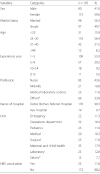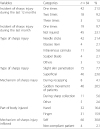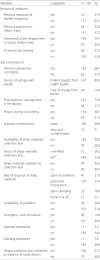Background
Sharps injury is a penetrating stab wound from a needle, scalpel, or another sharp object that may result in exposure to blood or other body fluids [1]. Infectious diseases potentially transmitted by sharps injury are constantly widespread and a significant cause of illness and death [2–4]. World Health Organization (WHO) global estimate showed that every unsafe injection and needle stick injury cause at least 8 to 12 million hepatitis B infections, 2.3 to 4.7 million hepatitis C infections and 160,000 HIV/AIDS infections [4, 5]. The Center for Disease Control and Prevention (CDC) estimated that each year 385,000 sharp injury was sustained by hospital-based health care personnel [6] during the course of their duty [7]. According to WHO pooled estimate, the annual incidence of sharps injury in Africa (Egypt, Senegal, and Mauritius) was ranged from 2.10 to 4.68 per person per year [8]. Specifically, the prevalence of sharps injury was 38% in UK [9] and 19% in Kenya [10]. In addition, a cross-sectional study in Portuguese [11], South Korea [12], and Thailand [13] hospital found out the prevalence rate of sharps injury was 64.5%, 70.5% and 55.5% sharps injury respectively. Even though researchers argued decrement of sharps injury in Ethiopian hospitals [14], the incidence of sharps injury have been alarmingly increasing [15]. A cross-sectional study conducted in Bale [16] and North Shoa [17] zone, Ethiopia revealed that the prevalence of sharps injury was 19.1% and 31.5% respectively. The risk of sharps injury at the workplace was related to syringe recapping (56%), intramuscular or subcutaneous injection (22%), specimen collection or intravenous cannulation (20%), transfusion (35.5%), and inadequate waste disposal (74.8%) [1, 7, 18]. Furthermore, other studies identified suturing, removing the needle from syringes after injection, sharps disposal were risky procedures that expose to sharps injury [13, 19]. There were several factors associated with increased risk of sharps injury: lack of training, extended working hours, job dissatisfaction, work experience, and perception of risk [20]. Moreover, age, poor compliance with infection-control procedures, and inadequate knowledge of blood-borne pathogens were associated factors for sharps injury [21].
The persistence of preventable, life-threatening occupational hazard particularly sharps injury at the hospital is yet to be given attention in developing countries including Ethiopia [8]. Therefore, the aim of the study was to investigate sharps injury prevalence and associated risk factors.
Methods
Study setting
The study was conducted in Debre Berhan Town, Northeastern Ethiopia. Debre Berhan is the capital city of North Shoa zone and located 130 km North East from Addis Ababa, the capital city of Ethiopia. The city has nine kebeles with a total population of 94,829 (50.8% female). There are 22 health institutions: two hospitals, three health centers, and 17 private clinics [17]. The study was conducted at the two hospitals considering the magnitude of sharps injury is high.
Study design and population
Institution based cross-sectional study was conducted from April to May 2016. The total number of source population in the two Hospitals was 434 healthcare providers (HCP): 384 at Debre Berhan Referral Hospital and 50 at Ayu General Hospital. All HCP who were actively involved in the patient care, fully employed, and at least with one-year work experience were included. However, HCP and managers who were on holiday, sick leave, and maternal leave were excluded.
Sample size and sampling procedure
The sample size was calculated using single population proportion formula. Given the prevalence of sharps injury was 28% [22], 95% confidence level, 5% marginal error, and 10% non-response rate, the final sample size was 200. Systematic random sampling (sampling interval /k/=2) method was used for selecting HCP.
Study variables
Sharps injury during the last 12 months was an outcome variable. The explanatory variables were demographic characteristics, behavioral attributes, and job environment characteristics. ‘Previous exposure to sharps injury’ was defined as observing the incident of sustained sharps injury by someone or inflicting sharps injury to oneself during the last 12 months. Besides, ‘previous exposure of needle recapping’ was defined as observing someone recapping a needle or needle recapping by oneself during the last 12 months.
Data collection
Self-administered structured questionnaire, which was adapted from WHO best practices for injections and related procedures toolkit [23], was used for data collection. The questionnaire has three sections: section 1_demographic characteristics; section 2_sharps injury; and section 3_behavioral attributes and job environment characteristics. First, the questionnaire was developed in English. Next, it was translated using the forward-backward method from English to Amharic (local language) by professional fluent in both languages. Finally, it was pre-tested at Kebele 04 health center. Five nursing intern students collected the data.
Data analysis
Before data coding and entry, the supervisor and investigators reviewed and checked each questionnaire for completeness, accuracy, and consistency. Printed frequency was used for checking missingness and outlying values. To test the hypothesized association of each explanatory variable with the outcome variable, bivariate and multivariate logistic regression analysis was done. Variables reached a p-value ≤0.25 were included in the final model. Variables with p-value ≤0.05 in the final full model test were identified as independently associated risk factors. Odds ratio with 95% confidence interval was used to measure the strength of association. Numeric summary measures, tables, and figures were used to present the data. The study was adherent to the Strengthening the Reporting of Observational Studies in Epidemiology (STROBE) statement [24]. Epi Info version 3.5.1 software package was used for data coding and entry whereas Statistical Package for Social Sciences (SPSS) version 20 software package was used for analysis.
Results
Demographic characteristics
In total, 195 HCP participated with a response rate of 97.5%. More than half (56.4%) of HCP were between the age of 25 and 30 years, 59.0% were female, 50.3% were married, 90.3% were working at Debre Berhan Referral hospital, and 43.6% were Nurse (Table 1).
Table 1
Demographic characteristics of HCP

Sharps injury
The prevalence of sharps injury was 32.8%. Table 2 presented, at least one out of five (21.5%) HCP sustained sharps injury once during the last 12 months. The most abundant type of sharps injury was needle stick injury (21.4%) followed by intravenous cannula (5.6%). Sudden movement of patients (20.5%) was the most frequent mechanism of sharps injury.
Table 2
Sharps injury among HCP

Behavioral attributes and job environment characteristics
Nearly three-fourth (69.7%) of HCP knew the department to report sharps injury. Half (50.3%) of HCP reported sharps material outside the sharps collection box. Seventy-five (38.5%) HCP reported the sharps collection box was available at distance of hand stretch (Table 3).
Table 3
Behavioral attributes and job environment characteristics

Association between demographic characteristics and sharps injury
As shown in Table 4, the profession was found significant risk factor for sharps injury. Midwifery professionals were 2.8 times more likely exposed to sharps injury compared with physicians, health officers, emergency surgeons, and anesthetist (p-value = 0.04, OR = 2.8, 95% CI = 1.02–7.92).
Table 4
Bivariate association of demographic characteristics and sharps injury

Association between behavioral attributes and job environment characteristics and sharps injury
As presented in Table 5, lack of in-service job training (p < 0.001, OR = 6.0, 95% CI = 2.95–12.03), previous exposure to sharps injury (p < 0.001, OR = 3.4, 95% CI = 1.82–6.48), unavailability of universal precaution guideline (p-value = 0.02, OR = 2.1, 95% CI = 1.14–3.90), and unavailability of sharps collection box at distance of hand stretch (p-value = 0.02, OR = 2.1, 95% CI = 1.11–3.77) were statistically significant associated risk factors for sharps injury.
Table 5
Bivariate association of behavioral attributes and job environment characteristics and sharps injury

Following adjustment for covariates, lack of in-service job training and previous exposure to sharps injury were statistically significant risk factors for sharps injury. HCP who had no in-service job training were 4.7 times more likely sustained sharps injury compared with those who had in-service job training (p < 0.001, OR = 4.7, 95% CI = 2.05–10.56). HCP who had previous exposure to sharps injury were 3.7 times more likely sustained sharps injury compared with those who were not exposed (p-value = 0.002, OR = 3.7, 95% CI = 1.62–8.27) (Table 6).
Table 6
Multivariate analysis of selected variables and sharps injury

Discussion
At least twenty large occupational groups are exposed to biohazards [25]. The risk is greatest among healthcare and laboratory workers who are threatened by the transmission of human pathogens including Hepatitis B Virus (HBV), Hepatitis C Virus (HCV), HIV/AIDS virus, malaria, syphilis, tuberculosis, brucellosis, herpes virus and diphtheria [7]. However, the World Health Organization (WHO) estimated 25–90% exposure to sharps injury remain unreported [7]. This study aimed to uncover the prevalence and associated risk factors of sharps injury among hospital HCP.
The prevalence of sharps injury among HCP during the last 12 months was 32.8%, which was in agreement with the prevalence rate reported in Ethiopia [17, 20] and United Kingdom [9]. However, the prevalence rate in our study was higher than the study report by Mbaisi et al. [10] in Kenya, Gessessew and Kahsu [26] and Bekele et al. [16] in Ethiopia. This inconsistency may be due to the difference in the operationalization of sharps injury, study population, the number of HCP in the facility, different work environment and culture and availability of resources [20]. In this study, the prevalence of sharps injury was highest in Midwifery professionals compared with nurses, physicians, health officers, emergency surgeons, and anesthetist. However, several earlier studies [16, 20] concluded sharps injury was highest in nurses.
In this study, the commonest mechanism of sharps injury was self-inflicted needle stick injury due to sudden movement of patients. Contrariwise, the Pakistani study indicated that the most commonly reported mechanisms for sharps injury were injection and two-handed recapping of the needle [19]. To avoid sudden movement, it is believed patients should be informed prior to any procedures that cause pain to prepare them psychologically. Agitated patients should be restrained manually or relevant medication should be given to calm them.
In accordance with earlier finding [20], multivariate logistic regression analysis in this study showed that a lack of in-service job training and previous exposure to sharps injury were significant risk factors for sharps injury. Due to lack of training, HCP may not have sufficient knowledge and skill to prevent sharps injury and perhaps increased the risk of injury as a result. A study carried out in Sub-Saharan Africa also supported the importance of training among HCP [27]. Previous exposure to sharps injury may decreased HCP perceived risk of sharps injury and they did not take precaution. This was supported by a study done in Gonder, Ethiopia where HCP with low perceived risk of sharps injury might not take special care to avoid injury while performing different activities using sharp materials [20].
Opposite to the conclusion by Bekele et al. [16], our study revealed that there was no statistically significant association between HCP work experience and rate of sharps injury. Our finding also supported by a study conducted in Northern Ethiopia [20] where work experience did not affect the risk of sharps injury. HCP working in the emergency unit had a higher risk of sharps injury compared with ophthalmology, dental, psychiatry, anesthesia unit workers. The possible explanation was that critical and risky procedure executed in the emergency unit [16].
The strengths of this study include a high response rate and the inclusive nature of this research as HCP could participate from all profession. Including hospitals where risky procedures carried out was a further strength. Moreover, a reasonable sample size was used. However, this study had certain limitations. Since the study was self-administered and the last 12 months incident was evaluated, social desirability and recall bias might added. Due to cross-sectional nature of the study, only temporal association was assumed between sharps injury and identified risk factors.
Conclusions
This study revealed 32.8% or at least three out of ten HCP exposed to sharps injury. This was found significant among HCP who had no in-service job training and who had previous exposure to sharps injury. Thus, the training of HCP should always be undertaken for new employees and periodically for those already employed. Moreover, periodical assessment of HCP knowledge and skills and training about the use of new medical equipments helps to prevent exposure to sharps injury [7].




 PDF
PDF Citation
Citation Print
Print


 XML Download
XML Download